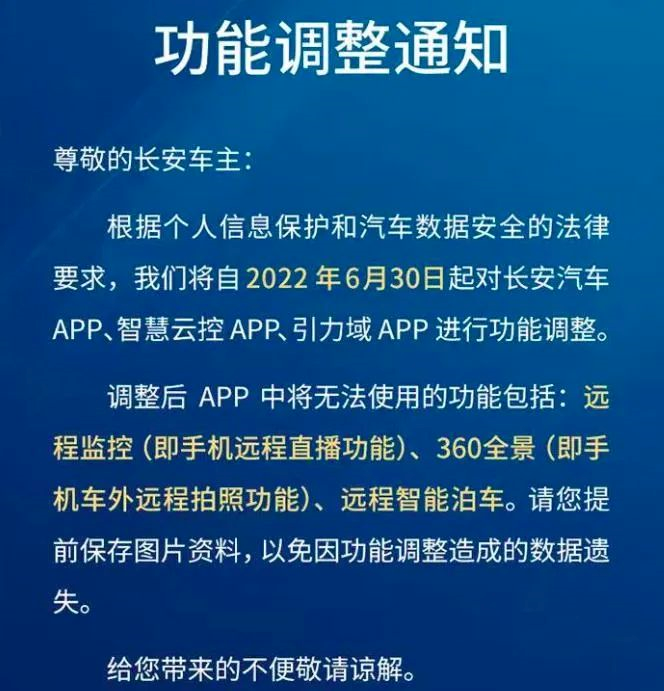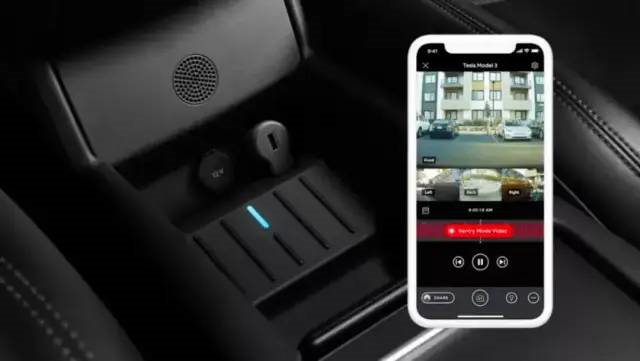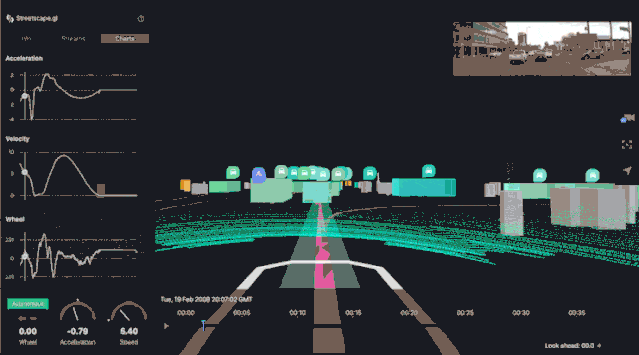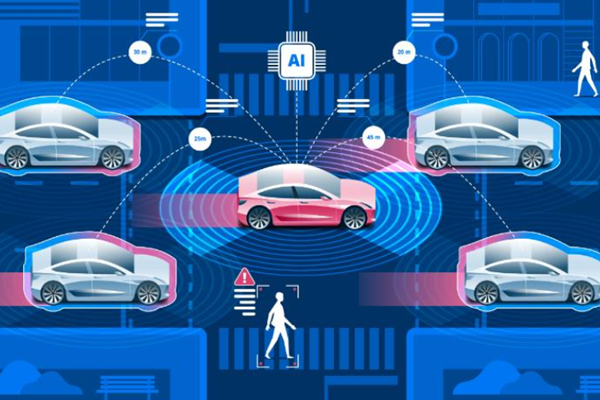Authors: Zhu Shiyun, Wang Lingfang
Editor: Qiu Kaijun
With the boundaries set, various cameras and radars that used to grow wildly cannot be turned on and collect information at will.
Recently, Changan Automobile officially announced the adjustment of its functions, stating that it will close the remote monitoring, 360 panoramic, and remote intelligent parking functions from June 30th, in accordance with legal requirements for personal information and vehicle data security.

In fact, Changan may “close late.”
According to “Electric Vehicle Observer,” many new carmakers, including XPeng Motors, and several Chinese car companies such as BYD, have removed the function of remotely accessing external car cameras from their apps. Even the inventor of this function, Tesla, has closed its “Sentry Mode” in China.
In other words, the functions that allow users to directly view/save the various original data collected by the vehicle’s external sensors are being restricted.
Compliance Requirements

“Compliance” is, of course, the direct cause.
In August 2021, the “Regulations on the Management of Automotive Data Security” (hereinafter referred to as the “Trial Regulations”) was jointly announced by the National Internet Information Office, the National Development and Reform Commission, the Ministry of Industry and Information Technology, the Ministry of Public Security, and the Ministry of Transport. It came into effect on October 1, 2021.
The “Trial Regulations” mainly define and regulate the collection, transmission, and use of data inside and outside vehicles from the aspects of the vehicle’s cabin data, sensitive data such as facial recognition/license plates, and personal privacy notice. They also assign responsibilities and rights to automotive data processors.
Among them, regarding the parts that involve external vehicle data such as remote monitoring, taking photos, or parking, the “Trial Regulations” require that: automotive data processors must obtain personal consent or meet other situations stipulated by laws and administrative regulations if they want to collect data from individuals, vehicle owners, or the external environment.
If it is impossible to obtain permission due to the need to ensure driving safety, and it is provided to the outside of the car, “anonymous processing should be carried out, including deleting images containing identifiable natural persons or performing partial contourization processing on face information in the image.”
In other words, when taking photos or videos, or remotely monitoring/controlling the vehicle, the license plates and faces seen by the vehicle owner should be blurred and desensitized so that they are not easily recognizable.It is worth noting that the “Trial Regulations” advocate the four principles that data handlers in the automotive industry should adhere to in carrying out automotive data processing activities, including: “The principle of in-vehicle processing, unless necessary, do not provide data to the outside of the vehicle.”
That is, under non-essential conditions, the data collected by the vehicle must be desensitized inside the vehicle before being provided to the outside world.
Previously, the hardware computing power and software layout at the vehicle end were mainly geared towards inference and execution, focusing on the output of results (images, sounds, driving movements displayed in the cabin). The data processing work, such as blurring images, is performed by cloud servers outside the vehicle.
How much is the cost of compliance?
Recognizing the images outside the vehicle, and coupled with the requirement to complete information desensitization in the vehicle, may become the fundamental reason for the removal of features from Chang’an and other automakers: the re-evaluation of the cost of compliance versus the benefits of features.
Considering that smartphones can directly achieve background blurring on the phone side, there is no significant technical barrier for automakers to achieve compliance in terms of technology.

Technical expert A Bao 1900 told “Electric Vehicle Observer” that to achieve compliance, vehicles need to undergo some upgrades at the software and hardware levels.
At the software level, the algorithm for recognizing and processing sensitive information in the image is not difficult. However, many automakers had not yet laid out in this field, and a certain development and testing cycle is required, which may take 2-3 months, and can be implemented on the vehicle end through OTA online upgrades.
But the prerequisite is that the hardware computing power must be sufficient.
The chip computing power at the camera end cannot support the requirements of image recognition/blur processing and generally needs to be processed at the domain controller level, most of which are placed in the cabin domain. A Bao 1990 estimated that high-end cabin chips such as Qualcomm 8155 (4TOPS) may be able to support desensitization processing at the vehicle end.
However, for models that use chips that do not support AI acceleration, such as the Qualcomm 820A, to meet vehicle-side processing, platform-level upgrades are required for this domain controller, with an overall hardware cost of around 1,000 yuan/vehicle, and a year of development and validation time.
In addition, whether the desensitization processing of images is ultimately done in the cloud or on the vehicle side, it means saying goodbye to real-time for consumers.
Even if high-computing-power chips support desensitization processing at the vehicle end, the algorithm still requires a few seconds of latency for image processing, a delay that will continue to increase as the camera becomes more high-definition and the image data becomes larger.
Obviously, whether it is the time required for technical implementation or the cost of hardware upgrades to be considered, automakers cannot complete compliance requirements at the first moment, which is also the fundamental reason for their removal of features ahead of time.However, whether it will be permanently phased out remains to be seen based on the effectiveness of the pilot implementation of regulations and how automakers balance compliance costs with functional benefits.
What about Intelligent / Autonomous Driving?

Since car owners cannot remotely access external cameras on their cars, does this mean that car manufacturers will also be limited in the development and implementation of intelligent/autonomous driving features? After all, vehicles also require rich external data collection to enable these features.
Currently, some domestic scholars believe that the “Trial Regulations” cannot be well integrated with the data collection needs for intelligent/autonomous driving. In order to enable these features, massive data collection and extensive data sharing are required. Under these circumstances, it will be very difficult to meet the requirements of the “Trial Regulations” and contradict the industry’s development laws.
In practice, “Electric Vehicle Observer” has learned that car companies currently use internal strict data security standards to protect data involved in data collection for intelligent/autonomous driving features.
This includes data security hardware modules on the car side, hardware isolation in uploading and storage, and setting regulations on data usage, to ensure that data is used to enhance the ability and implement functions of intelligent/autonomous driving systems within the company’s known and controllable scope.
Overall, although China has a relatively complete legal regulatory system concerning network security, data security, and personal information protection, concerning data collection for the implementation of intelligent/autonomous driving features, the country is currently using a gradual and procedural approach:
In the process of industrialization, exploring the types and scope of data required for smart/autonomous driving cars to operate safely, so that they can be effectively controlled within the “minimal necessary” principle.
At the national level, China’s industry associations have issued a series of requirements, including “Intelligent Networked Automotive Data Formats and Definitions” formulated by the China Association of Automobile Manufacturers, “Intelligent Networked Automotive Scene Data Image Annotation Requirements and Methods” and “Intelligent Networked Automotive LIDAR Point Cloud Data Annotation Requirements and Methods” formulated by the China Society of Automotive Engineers.
At the local level, the “Shenzhen Economic Special Zone Management Regulations for Intelligent Networked Cars” (hereinafter referred to as the “Shenzhen Regulations”) have entered the Shenzhen Standing Committee’s legislative plan for 2022, passed the pre-release of the third review stage, and are only one step away from official release.
If eventually released, the “Shenzhen Regulations” will become China’s first official document to regulate issues such as L3 and above autonomous driving responsibility, data management, and may promote Shenzhen to become China’s first city to allow L3-level and higher autonomous driving. This will further accelerate China’s positive exploration in the application and implementation of intelligent/autonomous driving technology.As cars really turn into robots in the real world, we are all standing on the frontier of the future that has never been reached before. Defining the functional boundaries of intelligent vehicles so that they become servers rather than violators, truly compatible with human society, will be a long-term test of wisdom for legislators and practitioners.
This article is a translation by ChatGPT of a Chinese report from 42HOW. If you have any questions about it, please email bd@42how.com.
